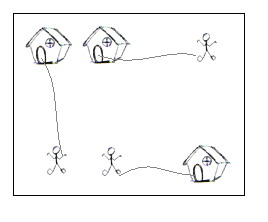Description
On a grid map there are n little men and n houses. In each unit time, every little man can move one unit step, either horizontally, or vertically, to an adjacent point. For each little man, you need to pay a $1 travel fee for every
step he moves, until he enters a house. The task is complicated with the restriction that each house can accommodate only one little man. Your task is to compute the minimum amount of money you need to pay in order to send these n little men into those n different
houses. The input is a map of the scenario, a '.' means an empty space, an 'H' represents a house on that point, and am 'm' indicates there is a little man on that point.


Input
There are one or more test cases in the input. Each case starts with a line giving two integers N and M, where N is the number of rows of the map, and M is the number of columns. The rest of the input will be N lines describing
the map. You may assume both N and M are between 2 and 100, inclusive. There will be the same number of 'H's and 'm's on the map; and there will be at most 100 houses. Input will terminate with 0 0 for N and M.
Output
For each test case, output one line with the single integer, which is the minimum amount, in dollars, you need to pay.
Sample Input
2 2 .m H. 5 5 HH..m ..... ..... ..... mm..H 7 8 ...H.... ...H.... ...H.... mmmHmmmm ...H.... ...H.... ...H.... 0 0
Sample Output
2 10 28
二分图匹配求最小值,因为原方法求的是最大值,那将每条边转换为负值,所求最大值实际上就转换为了求最小值。
#include<stdio.h> #include<stdlib.h> #include<math.h> #include<string.h> bool vx[100],vy[100]; #define MAX -(0xfffffff) int match[100],map[100][100],lx[100],ly[100],n,lack[100]; char map1[100][101]; struct house { int x,y; }h[100]; struct man { int x,y; }M[100]; bool hungray(int i) { int j; vx[i]=1; for(j=0;j<n;j++) { if(vy[j]) continue; if(lx[i]+ly[j]==map[i][j]) { vy[j]=1; if(match[j]==-1||hungray(match[j])) { match[j]=i; return 1; } } else if(lx[i]+ly[j]-map[i][j]<lack[j]) lack[j]=lx[i]+ly[j]-map[i][j]; } return 0; } int km() { int i,j,d; memset(ly,0,sizeof(ly)); memset(match,-1,sizeof(match)); for(i=0;i<n;i++) { lx[i]=MAX; for(j=0;j<n;j++) if(map[i][j]>lx[i]) lx[i]=map[i][j]; } for(i=0;i<n;i++) { for(j=0;j<n;j++) lack[j]=-MAX; while(1) { memset(vx,0,sizeof(vx)); memset(vy,0,sizeof(vy)); if(hungray(i)) break; d=-MAX; for(j=0;j<n;j++) if(!vy[j]&&lack[j]<d) d=lack[j]; for(j=0;j<n;j++) { if(vx[j]) lx[j]-=d; if(vy[j]) ly[j]+=d; else lack[j]-=d; } } } d=0; for(i=0;i<n;i++) d+=(lx[i]+ly[i]); return -d; } int main() { int N,m; while(scanf("%d%d",&N,&m)!=EOF&&N&&m) { int i,j; int allm=0,allh=0; for(i=0;i<N;i++) scanf("%s",map1[i]); for(i=0;i<N;i++) for(j=0;j<m;j++) if(map1[i][j]=='m') { M[allm].x=i; M[allm++].y=j; } else if(map1[i][j]=='H') { h[allh].x=i; h[allh++].y=j; } n=allm; for(i=0;i<allm;i++) for(j=0;j<allh;j++) map[i][j]=-abs(M[i].x-h[j].x)-abs(M[i].y-h[j].y); printf("%d\n",km()); } return 0; }





 本文介绍了一种使用二分图匹配算法解决特定地图上小人到房子的最短路径问题的方法。通过将问题转化为求最小权值匹配问题,并采用匈牙利算法进行求解。文章详细解释了算法实现过程及核心代码。
本文介绍了一种使用二分图匹配算法解决特定地图上小人到房子的最短路径问题的方法。通过将问题转化为求最小权值匹配问题,并采用匈牙利算法进行求解。文章详细解释了算法实现过程及核心代码。
















 1372
1372

 被折叠的 条评论
为什么被折叠?
被折叠的 条评论
为什么被折叠?








